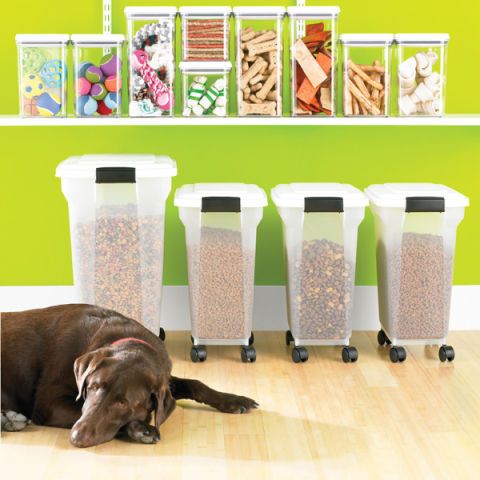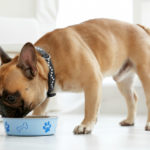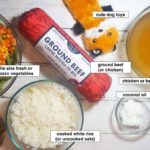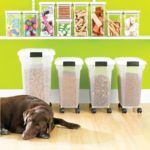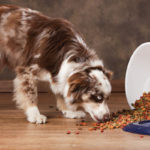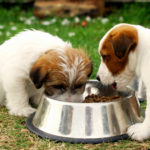How to store dog food – Just like human food, pet food needs proper and careful storage to stay fresh and edible for consumption. Beyond finding out if the right ingredients are being used to prepare your dog food or checking for the perfect food brand and choice of food texture to give your dog, storing them to maintain their freshness and balanced composition is perhaps as important for your dog’s feeding convenience.
There is a lot of good taking the proper measures in storing your pet food could save your pet like food poisoning from contaminated surfaces and decay as it helps preserve the quality, texture and freshness of the food your dog is consuming especially when storing for a long time.
But it is not enough to just keep the food bag tucked in on the cupboard or shelf because with changing weather conditions, what will guarantee you freshness is a stable and constant environment and because you have been asking, here are important facts you need to know to help you store your dog food be it dry, wet or raw better. There is no guarantee with the changing weather condition and environment, the risks of preservation can be quite disastrous which is why you need to know the factors that can affect it and how to preserve it better.
Storing dry dog food:

One of the reasons why many pet parents prefer Kibbles to canned food is because of its ability to last longer and the dogs live the crunchy taste of it too. But this crunchy delight when poorly stored, can lose its freshness and quickly become an airy-soft and distasteful meal for your doggie.
There are three major factors that are responsible for the quickening damage of dry food in storage:
Light because it is a source of heat generation which radiates through the meal and leaves it warm, Humidity makes for hot, moist environment as it contains water vapour and Oxygenated air which is particularly responsible for the change in the crunchy dry texture, to soft and causes a degradation of fat in the food.
Although, it contains a low moisture, dry food is formulated with a high fat content than the wet food and if allowed to come in contact with oxygen, the fat can easily become soluble and rancid which is bad for digestion.
But all this boils down to poor storage and with the right information on the proper method of storing dry foods, your bulk purchases would no longer be in vain again. Below are a few steps with the right information to follow:
- Before purchasing and/or using any bag of dry food, check the body of the bag properly (that is if you are buying from a physical store)to make sure it is free from any openings or tears around the body and lid. Inspect the goods immediately after every delivery and do not feed any of its content to your dog as you do not know for how long it may have been opened.
- Purchase only bags that have been vacuum-packed as they have been de-aired and very likely pumped out of almost all the oxygen that could make the food go bad easily.
- Reseal lids after every use by pressing both kids together. In a case where the package does not come with a resealable lid, fold the lids tightly or clip them with a peg and store them with their original packaging in an airtight BPA-free container, a stainless container or a Ziploc bag.
- For extra caution, oxygen-absorber pads are great for keeping out any of the remaining g oxygen left in the pack to keep the product fresh. Food processing companies produce food in vacuum-packed bags to help keep oxygen out for long lasting freshness while on the shelf.
- Consult the best before date on the package label to enable you know just how best store your food for a long term.
- Store in cool, dry and dark place away from sunlight and off the floor away from rodents.
- Apply clove oil around the rim of the jar. This is great for keeping away ants and other pests that may likely surround the jar.
- The best environment to store a bag of dry Kibbles is in a Cool, dry, dark place on the top of a kitchen cupboard, shelf and pantry away sealed in an airtight metal or plastic container that cannot be nibbled on by rodents nor infested by rats.
- Automatic kibble dispensers are great for making mealtime for your dog with little need for opening and closing containers. But if left in fir too long, the kibbles stand the chance of Pest infestation from the tiny holes of the dispensers. They do not also make for the best environment for storing food for a long time.
- Use up old bags of food completely before adding new bags into the container. Before adding a new bag to the container, first empty out the remnants of the old and thoroughly clean out the container to avoid any case of the old taste affecting the freshness of the new container.
- Freezing dry food at high temperature is not recommended but you can refrigerate it for up to six months to keep it cool and fresh. The note though, that keeping dry food in the fridge can leave it susceptible to moisture and if left for too long lose its flavour
- Microwaving dry kibbles would only leave it burnt, too dry and might even burn your dog. They are omnivores and have once lived in the wild forest so can adjust to eating their food without any need for heating.
- Opened bags should be consumed first and the container cleaner out properly before storing another one to prevent creating an unhealthy environment for the next bag particularly if the old one has been there for quite a while.
- Always store all dog foods indoors as room temperature no matter the change in weather is not as extreme as that of the outdoor environment.
Appropriate Storage Containers
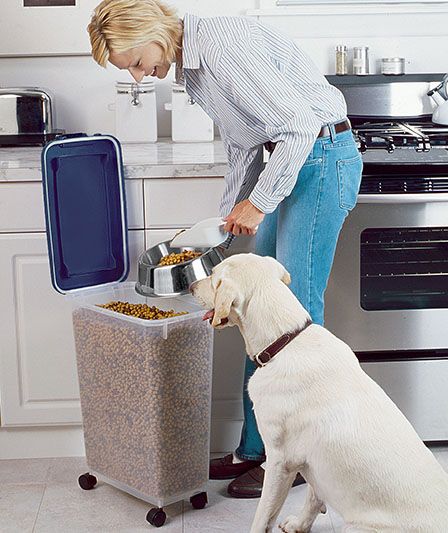
- The most appropriate plastic container to use are BPA-free, airtight containers as they do not contain the chemical used to preserve plastic containers and have lids that do not always require constantly unscrewing the lid. They also have Silicone rubbers which are very good for keeping away moist and providing a regular temperature for the rubber. Tupperware plastic containers are not usually recommended because of their composition which from research is found to cause
- Before using any container, clean it out thoroughly to make sure that it is rid of production odor as this could affect the taste of your food. Keep dry food tight in its original bag before storing it in the container. This will help to prevent the entrance of air and keep it safe from moisture that could make it go rancid for which studies have shown that rancid fat can lead to a deficiency in a balanced meal for your dog’s nutrition.
- Stainless containers are also considered to be perfect for storage as do not hold in much Oxygen and are always cool in all seasons which is the perfect temperature for storing them.
- Zip-lock bags are also recommended but only the ones with proper resealing lid as it does not work efficiently at providing a Oxygen-free environment for the food. Which is why, it is usually advised that you flatten it out to remove all the Oxygenated-air in it and keep the food tightly clipped in its lack before depositing into the bag.
- Do not store or in a Garbage bag or bin or can especially in an outdoor location as they are prone to change in weather conditions and can easily lose their freshness this way.
DIY airtight containers for storing dry food
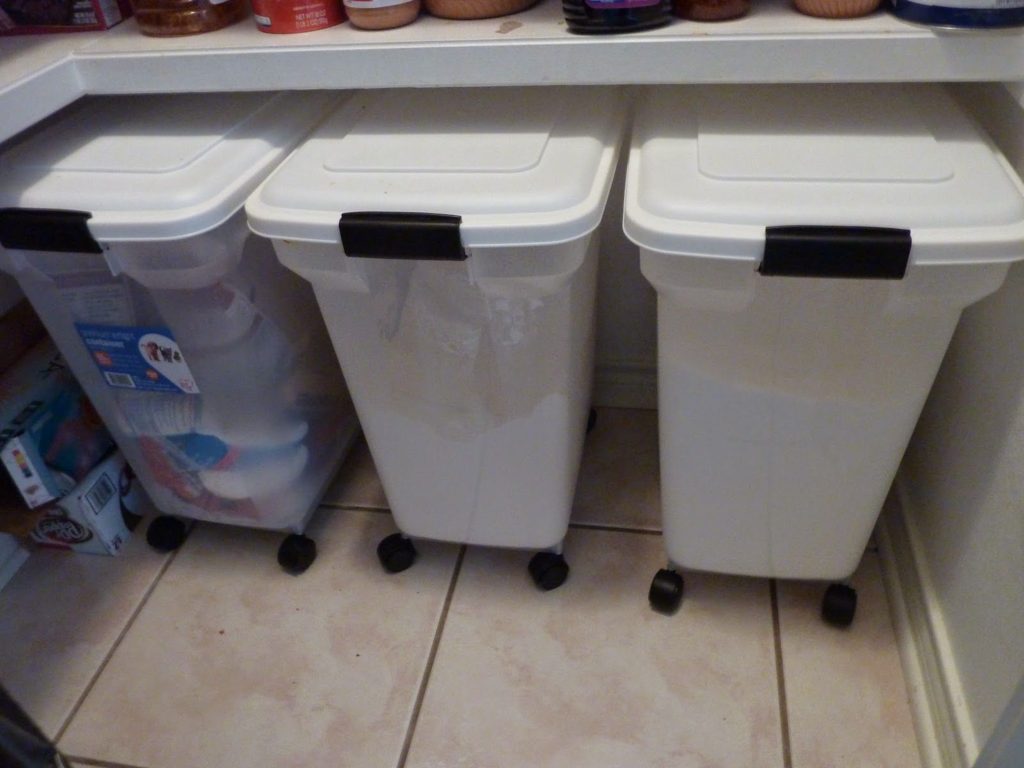
Old suitcases are great for storing large quantities of dog food for long term purposes as they check the box for cool, dry and dark storage spaces. Make sure they are well cleaned and rid of camphor scent as it is unhealthy for consumption.
Juice cans are also great for converting into food containers with its easy to pop top containers that are easy to open and close without giving too much to air contamination. Before using, ensure that the container has been thoroughly cleaned of moisture and makes for ease when pouring out food.
Baby diaper pails are great for storing dry food as they have been made specifically with odor-free containers with silicone-free covers to keep freshness locked in.
Storage duration
Insidethefoodbowl, dry food can stay for a maximum of 24 hours without going bad but it advised that you should clean out the bowl with soap and water for a fresh refill.
Once opened, dry food can last up to a year and perhaps a few additional months. Unopened bags of food are likely to stay stored in safe environments for about two to three years. It is not always advised that the food be consumed after the best before on the purchase bag but even a few months after expiry, dog food can still be consumed though with led nutritional value.
Keep off the hardwood or cold tiles and away from your dog’s nose on to the highest level in your kitchen shelf or pantry.
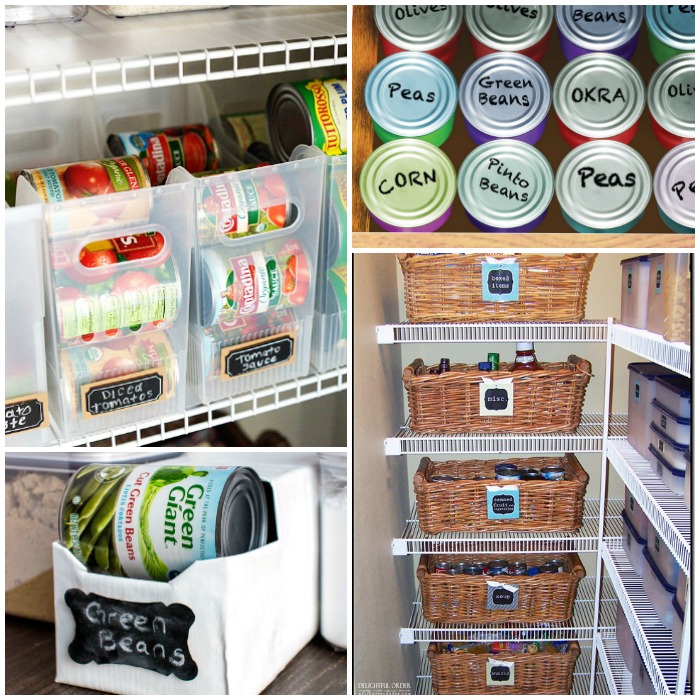
Canned food; Shelf life and Storage tips
Canned food contain more moisture and less fat than dry food and are usually always preferred because of the ease of digestion in every balanced meal. Unfortunately, because if its moist condition, it us also very prone to bacteria and is very susceptible to getting bad easily. These tips are chock full if I formation that will hwlo you better store the dog food while forgetting the fear of it getting spoilt that even leftovers would be served fresh when next meal time arrives.
- Before purchasing a canned dog food, it is just as important that you check the Best before on the bottom of the tin for production Shelf life. The best before is the manufacturer’s expected duration of potency for ingredients used in producing the meal. It is not to be confused with the expiration as you could still serve your dog a food that has gone past the date, however it is the period when the nutrients begins to suffer breakdown and become less active.
- Avoid buying canned food with swellings or puncture in them as they could be responsible for botulism, an acute food poisoning caused by a toxin that us both harmful to man and animal and produced in moist food like Canned foods by the bacteria Clostridium botulinum usually formed in moist environments.
- The high moisture content makes, opened canned food easy substances for bacteria contamination and if eaten after a long period of time by the dogs could put him at risk of food poisoning. Which is why serving out only portions that your dog can consume at once is a better option .
- Four hours is the maximum time for opened Canned food to be left u eaten. If after this duration, the food should be thrown out and the bowl rinsed out thoroughly for fresh refill. For little dogs with lower appetite, you can always check out on the dog food aisle and on dog food e commerce stores for smaller plates that can be consumed at once.
- It is not always advisable to let your dog eat straight from the can as not only is it unhealthy, it also leaves the food messy and could give way for mold even especially when stored.
Storing Opened Canned food
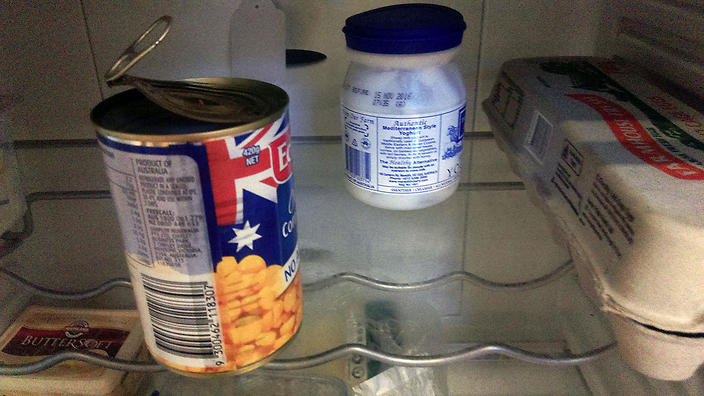
- Storing canned food in the refrigerator is very important as it helps the canned food in retaining its moisture content nevertheless, if loosely sealed could easily give rise moldy surface from contact with air. To avoid this, it should be resealed with properly with a plastic can cover which snaps over the top of the aluminum container and keeps it airtight till its next use. Foil packs can so be used to reseal the container too as they are less porous to air.
- Plastic can covers and plastic wrapping protect the tin against moisture and serve as effective barriers protecting opened cans against oxygen and odor from other food
- If sealed properly, the canned food can last for three to four days without any signs of staleness and be served fresh for when mealtime calls. But once unsealed, it should be consumed immediately as the air could be bad for quality.
- For long term storage, it is not advised to freeze Canned food directly in their original container as this could change the taste and texture of the food making it unpalatable for consumption.
- Zip lock bags are a great storage pack for keeping wet food especially for long period of time. For freshness, scoop single serving portions into each zip lock bag, reseal to keep moisture away and spread each one separate from one another on a tray. Label each bag of food with dates especially if they were not stored at once to avoid leaving anyone in the fridge for too long. They are also quick and easy to defreeze under warm running water.
- In the absence of a zip lock bag, stainless containers are also effective to keep moisture away for a long period of time.
- Depending on its ingredients, canned food when left unopened can stay up to five years maximum especially counting from its best before. Canned food with natural preservatives are not likely to last far too long after their best buy dates and are at risk affect of getting spoilt.
- Unopened canned food should be stored indoors under room temperature away from heat and humid weather.
- If perhaps you are in a rush and consider a full tin of canned food too much to be consumed at once for your dog, serve in smaller portions and watch over him till it’s finished. For dogs with portioned appetites, there are also products on dig food aisles and e-commerce stores with one-serving small portion for quick and easy consumption.
- Store older cans directly in front of new cans to ensure their immediate use
- After going over canned food, wash your hand thoroughly as this could also affect the food .
Storage preservation for home cooked meals

While making or ordering home cooked meals for your dog, knowing how to store them to preserve their nutritional content is very important to avoid unnecessary waste. Especially when cooking in batches, just storing them up in the refrigerator is important but not enough to make sure that not only does your dog eat a fresh, healthy and balanced meal but the efforts put into the meal preparation is not wasted from poor storage. A ton of tips you would need to know while preserving homemade foods.
Most of the food preservation methods for dog follow the same guiding process with our own meal preservation so it should be easier to know which should last long and stay healthy for your dog’s consumption. A few things should be noted:
- Stainless containers and glass-like plastic with airtight lids are great for keeping them safe and refrigerated till next use. Check for refrigerator-friendly materials on Amazon or ask your retail attendant when next you go to buy food storage cans for a great recommendation.
- Food types like grains do not get to stay in the fridge for too long and are likely to lose their quality if frozen and should be eaten after a few days.
- Very little microwaving is necessary when serving a meal from the refrigerator as digs unlike us are capable of digesting food better when it’s not warmed do not need the hot freshness of food like we do.
- Wash out leftover meals after about an hour of serving them as they are unhealthy and make great breeding grounds for insects. Thoroughly wash and rinse the food bowl and wash your hands carefully.
Preservation techniques for Raw Food
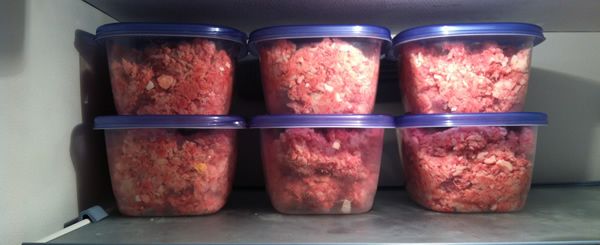
Raw food is fast becoming a craze for pet owners as it is both a healthy and stress-free means of making sure that your dog’s diet is fresh and safe from Tue unknown preservatives obtained with fast food. To make sure that the food this raw food dies not end up getting, or decayed from lack if proper storage this tips are important to note.
Deep freezing: In every household where raw food is purchased especially in bulk, a deep freezer is always available to store the food for as long they are required. This could also serve to help preserve raw meat from getting rotten. For raw diets packaged directly frim the store, they should be kept in their original packaging and carefully wrapped after every opening.
If you buy the raw meat from the store without any package on it, wrap them properly in a foil pack or in a plastic wrapping bag to keep them fresh away from contamination and easy to portion out when needed. Raw food diets can diffuse quite an odor and affect other food containers especially when kept in the fridge which is why it important to store them in a different compartment away from other food diets.
Portion food according to the breed and appetite size of your dog; Larger breeds eat in large quantities and their should be portioned out in larger quantities as it can be easy to defrost a single pack of raw diet without any chances of leftover. For small dog breeds it is better to check out for kibble sized raw food diets that can be portioned according to their appetite without defrosting the entire meat.
Frozen food can be thawed overnight inside a tightly sealed container in a standard refrigerated condition for approximately twelve hours. In a case where you were jot able to bring it out on time, it should be sealed in a Ziploc bag and soaked in water for a few minutes.
Defrosted meat can last for two to three days after which it stands a risk of going bad. Bacteria such as Salmonella lives in raw meats and although when eaten immediately raw meat is easily digested without the bacteria multiplying but if left out too much, it has the capacity to multiply and can become harmful in the digestive tract system.
Freezer temperature is best for storing raw meat as opposed to room temperature which makes it a great breeding ground for the multiplication of Bacteria. Also, it is not recommended that you store raw food in plastic containers especially Tupperware. Stainless steel and metal containers are best quality for storage and should be cleaned once every week with vinegar and water to kill off bacteria like Salmonella and E.coli from previous meat stored.
Wash your hands properly before handling raw food items and after handling, wash and sanitize every utensils, tables surfaces and your hands to avoid the spread of bacteria from the meat to the members of your family, your health and that of your pet.
Tips for storing freeze-dried raw food

For a guarantee of long-lasting freshness, moisture is usually drained from fresh foods and kept frozen for a long time till they are purchased and this method of preservation keeps food healthy and fresh for as long as possible. For raw food diet, this is one of the best ways to keep it in its original form with only a little sprinkling of water for thawing. But it needs the right environment to be stored safely.
Due to its zero-moisture condition, humidity and heat are not the best conditions to store them in as it could give rise to the growth of mold spores and bacteria. For Vegetables, do not wrap them in bags as they could shrivel and lose their original quality. So, it is best to wrap them in an old newspaper and store in the vegetable compartment of the fridge till it is ready to be used.
Kept away from light and heat as they are subject to shrinkage and could lose their nutritional value.
Tips for storing dehydrated raw food
As opposed to the freeze-dried , dehydrated raw foods use heat to dry out its moisture content. It is the most effective way of preserving raw food as it helps to protect the food from decay or mold. But there are .few tips necessary to make sure it is kept safe for as long as it should be eaten.
Dehydrated protein sources also serve as a great treat for rodents and should be carefully wrapped in foil wraps and stored in a cool, dry and dark place.
Reheat after a period of three-six months to keep it fresh.
ALSO SEE: Dog Food – An In-depth Guide
Popularly Asked Questions and Answers
Q: What form of food is best stored for emergency situations and why?
Dogs are very likely to hold through an emergency situation just like we human beings with whatever might be available but preparation is very necessary especially if time permits to prepare just enough time to store needed food times and requirement for emergency situations. But for ease of preservation, canned and freeze-dried foods are best for keeping your dog full during emergencies. This is because they contain low-fat content and this is particularly important while thinking of storage. Also, canned food contains lots of moisture so your dog stays constantly hydrated throughout.
Q. Is it okay to salt meat as a form of preservation instead of freezing it?
The answer is no. While salting has been regarded as one if the best ways of preserving wat, it does not go well with dogs and should not be used in any form even while preparing home cooked meals.
Q. My dog prefers fish as he is allergic to other sources of protein plus I home cook his meals.How do I preserve fish outside freezing to maintain its freshness for a long time?
Good question. Fish can be canned with minimal preservatives to elongate its shelf life for a few years but does not get to stay beyond that as it contains oil that has the tendency to go bad inside the container.
Q. How do I know if oil has gone rancid in my dog’s food?
It starts to smell and taste like plastic. Also, watch your dog after feeding him to see how if he turns down his nose at the food instead of eating it.
Q. Are there any natural preservative that could keep canned food for long?
The maximum term for natural preservatives is three-five years but you can consult your Vet to know more on natural preservatives for longer shelf life of canned food.
Q.Are there any health implications for storing food for long in the refrigerator?
Storing canned food can put other food at the risk of wearing its odor on their wrapping jackets and keeping meat with bacteria under poor freezing can give bacteria a stable breeding environment for multiplying. But as long as you maintain proper sanitary measures like making sure to wash your hands and fridge with proper sanitary measures and cover the canned food properly with plastic wraps you have no cause to fear.
Q. What happens to raw food that may have been frostbitten? Is it still healthy to eat?
Frostbite is not healthy for food as it renders all the nutritional content of such food useless. So if you find out that your raw food has been bitten by frost and cracked, throwing it away is the best possible option as it serves no nutritional value for your dog.
Q. Does dehydrated food have any chance of getting spoilt in the long run?
As long as it is kept under cool conditions, away from moisture it stands the chance of lasting for a very very long time.
Q. Can free-dried foods stay too long out of the fridge without going dry?
Yes, they can because they lack moisture which is mostly responsible for making meat go bad. They are also great for preserving nutrients and can last long in cool, dry with a stable shelf-life.

